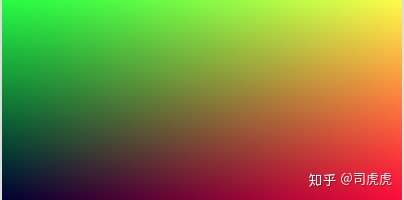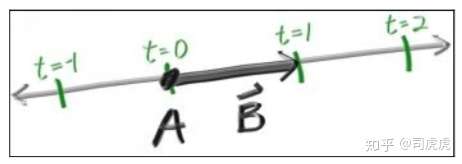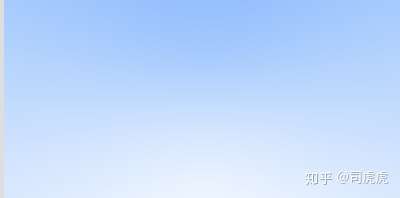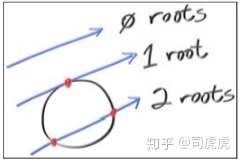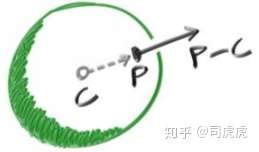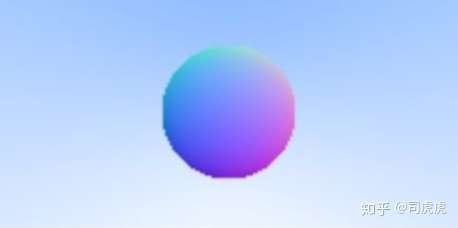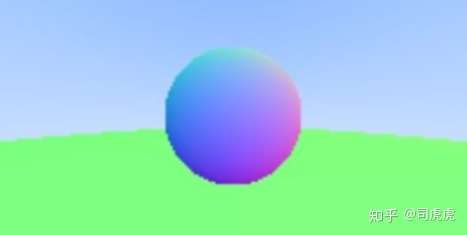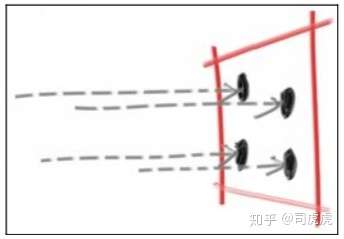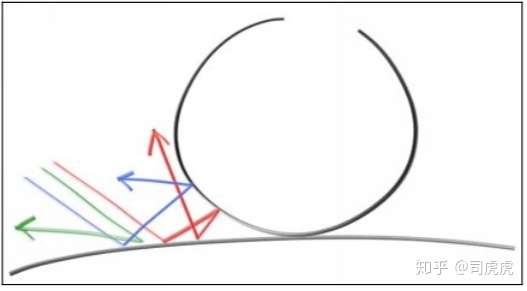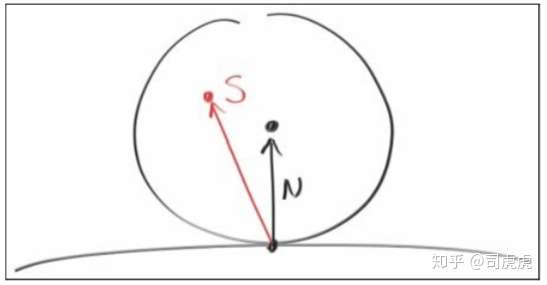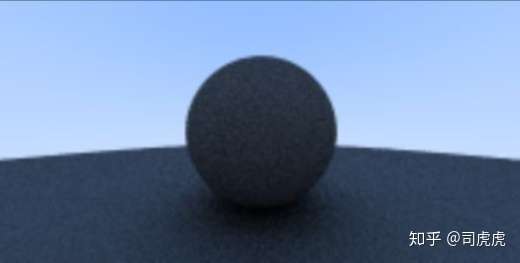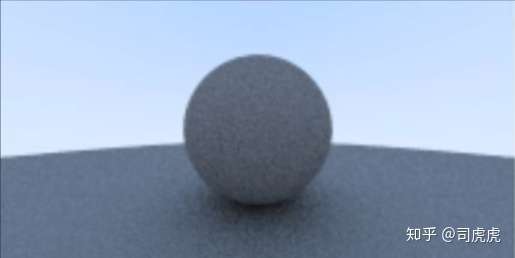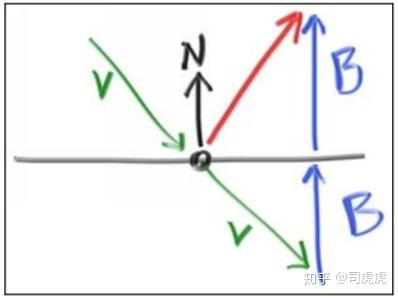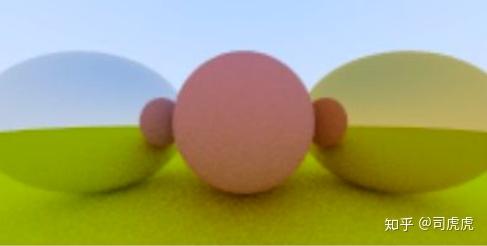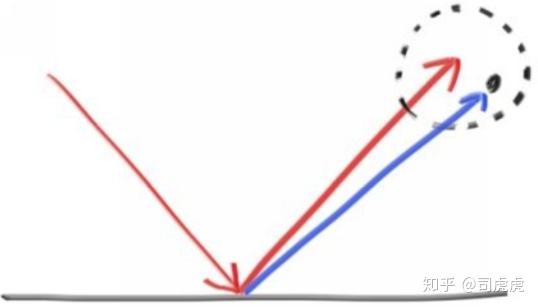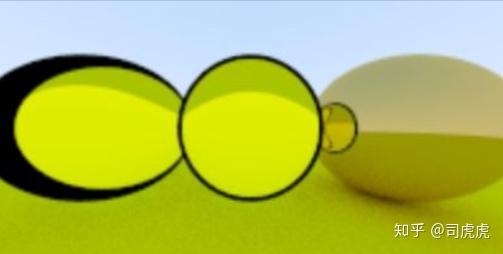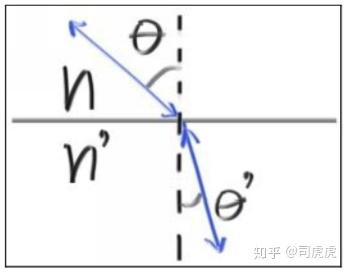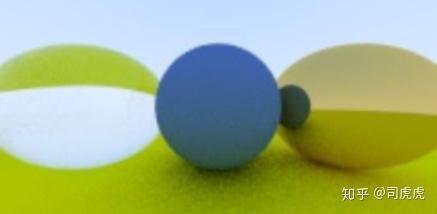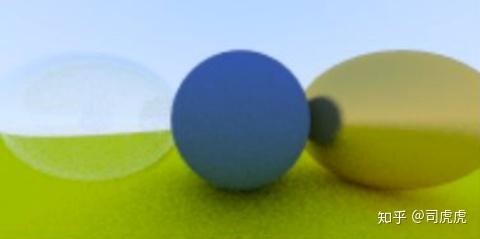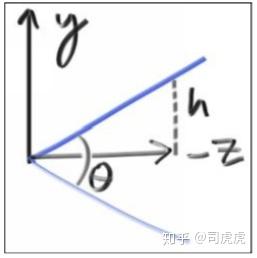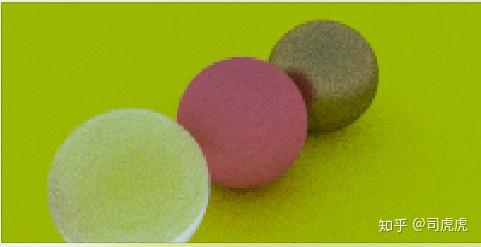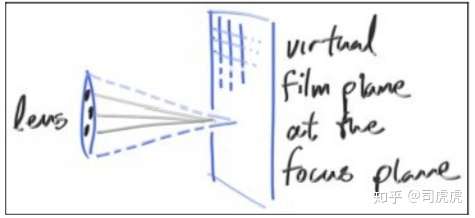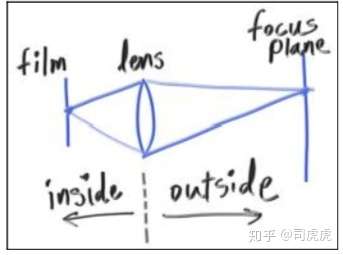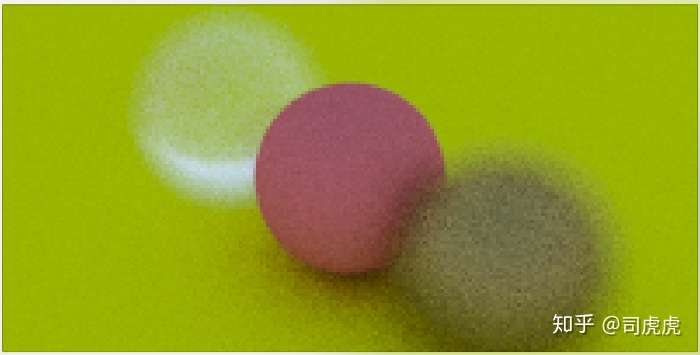原著:Peter Shirley
本书是Peter Shirley ray tracing系列三部曲的第一本,也是学习ray tracing 入门比较容易的一本书,自己照着书上的内容,抄了一遍,Github有完整的代码,和每一章学习过程的代码,部分代码加了注释。
英文原著地址 密码: urji
- Chapter1:Output an image
- Chapter2:The vec3 class
- Chapter3:Rays, a simple camera, and background
- Chapter4:Adding a sphere
- Chapter5:Surface normals and multiple objects
- Chapter6:Antialiasing
- Chapter7:Diffuse Materials
- Chapter8:Metal
- Chapter9:Dielectrics
- Chapter10:Positionable camera
- Chapter11:Defocus
- Chapter12:Where next?
使用ppm渲染到图片
#include <iostream>
using namespace std;
int main()
{
int nx =200;
int ny=100;
cout<<"P3\n"<<nx<<" "<<ny<<"\n255\n";
for(int j=ny-1;j>=0;j--)
{
for(int i=0;i<nx;i++)
{
float r=float(i)/float(nx);
float g=float(j)/float(ny);
float b=0.2;
int ir=int(255.99*r);
int ig=int(255.99*g);
int ib=int(255.99*b);
cout<<ir<<" "ig<<" "<<ib<<"\n";
}
}
}说明:
- 像素从左往右打印
- 从上向下打印
- 这个例子中RGB计算出来在[0,1]之间,输出之前映射到一个高范围空间
- 红+绿=黄
- 打印的内容保存成.ppm格式即可预览
用于几何向量计算和颜色计算,包含颜色,向量,位置坐标,偏移,主要包含重写操作符,以及点乘、叉乘等操作。
class vec3 {
public:
vec3() {}
vec3(float e0, float e1, float e2) { e[0] = e0; e[1] = e1; e[2] = e2; }
inline float x() const { return e[0]; }
inline float y() const { return e[1]; }
inline float z() const { return e[2]; }
inline float r() const { return e[0]; }
inline float g() const { return e[1]; }
inline float b() const { return e[2]; }
inline const vec3& operator+() const { return *this; }
inline vec3 operator-() const { return vec3(-e[0], -e[1], -e[2]); }
inline float operator[](int i) const { return e[i]; }
inline float& operator[](int i) { return e[i]; };
inline vec3& operator+=(const vec3 &v2);
inline vec3& operator-=(const vec3 &v2);
inline vec3& operator*=(const vec3 &v2);
inline vec3& operator/=(const vec3 &v2);
inline vec3& operator*=(const float t);
inline vec3& operator/=(const float t);
inline float length() const { return sqrt(e[0]*e[0] + e[1]*e[1] + e[2]*e[2]); }
inline float squared_length() const { return e[0]*e[0] + e[1]*e[1] + e[2]*e[2]; }
inline void make_unit_vector();
float e[3];
};
所有的ray tracers 都是以ray类为基础,计算颜色 p(t) = A + t*B 其中A是光源点,B是ray的方向,t是具体float值,空间中确定一条线,不同的t,可以到达不同地方。
p(t)称为点A关于t的函数。Ray tracing的本质是通过发射射线,计算像素点的颜色。在ray tracing之前需要有个摄像机,建立坐标系,显示背景色,以及ray hit的点的颜色。
假设摄像机的位置就是眼睛位置,看到的内容为ppm显示的东西,简历坐标系,z轴正方向,垂直平面向外,x向右,y向上,
计算公式:
blended_value = (1-t)*start_value + t*end_value
球的公式:
x*x + y*y +z*z = R*R
对于任意xyz,如果满足球面公式,(x,y,z)为球面的一个点。
如果球心位置为(cx,cy,cz),公式为
(x-cx)*(x-cx) + (y-cy)*(y-cy) + (z-cz)*(z-cz) = R*R
用向量表示,球面点P,球心点C,半径可以表示为向量PC
dot((p-C)(p-C)) = (x-cx)*(x-cx) + (y-cy)*(y-cy) + (z-cz)*(z-cz)
等价于
dot((A + t*B - C),(A + t*B - C)) = R*R
展开之后
t*t*dot(B,B) + 2*t*dot(A-C,A-C) + dot(C,C) - R*R = 0
ABC已知,这里是一个关于t的一元二次方程,对于t无解,有一个解,有两个解的情况,即为下图
通过打印颜色,利用红色的射线,ray hit 圆,hit到的地方显示红色
bool hit_sphere(const vec3 & center, float radius,const ray& r)
{
vec3 oc = r.origin() -center;
float a = dot(r.direction(), r.direction());
float b = 2.0 * dot(oc,r.direction());
float c = dot(oc,oc) -radius*radius;
float discriminant = b*b - 4*a*c;
return (discriminant>0);
}
vec3 color(const ray& r)
{
if(hit_sphere(vec3(0,0,-1),0.5,r))
return vec3(1.0,0,0);
vec3 unit_direction = unit_vector(r.direction());
float t = 0.5 *(unit_direction.y() + 1.0);
return (1.0-t)*vec3(1.0,1.0,1.0) + t*vec3(0.5,0.7,1.0);
}法线是垂直与物体表面的一个向量,对于上一节提到的球,他的法线方向是,从球心出发,射向hitpoint的。就像在地球上,地面的法向是从地心出发,射向你站立的点的。
假设N是长度在[-1,1]之间的单位向量,映射到去见[0,1]之间,再映射x/y/z到r/g/b,通常除了须要知道是否hit点,还要拿到hit point的数据。
// 本章 hit_Sphere的返回值改为float了
float hit_sphere(const vec3 & center, float radius,const ray& r)
{
vec3 oc = r.origin() -center;
float a = dot(r.direction(), r.direction());
float b = 2.0 * dot(oc,r.direction());
float c = dot(oc,oc) -radius*radius;
float discriminant = b*b - 4*a*c;
if(discriminant<0)
return -1.0;
else
return (-b-sqrt(discriminant))/(2.0*a);
}
vec3 color(const ray& r)
{
float t = hit_sphere(vec3(0,0,-1),0.5,r);
if(t>0.0)
{
// 球心到hitpoint的单位法向量
vec3 N = unit_vector(r.point_at_parameter(t)-vec3(0,0,-1));
return 0.5*vec3(N.x() +1,N.y()+1,N.z()+1);
}
vec3 unit_direction = unit_vector(r.direction());
t = 0.5 *(unit_direction.y() + 1.0);
return (1.0-t)*vec3(1.0,1.0,1.0) + t*vec3(0.5,0.7,1.0);
}
当场景中有多个可以被击中的物体的时候,需要一个Hitable的抽象类,包含抽象方法hit 是否击中,以及记录hit到的数据,包括hit的位置,hit点的法向,以及距离t
通过距离t tmin< t < tmax 来控制hit到物体的距离远近,因为hit到之后将不再往后ray tracing。
#include "ray.h"
struct hit_record
{
float t;
vec3 p;
vec3 normal;
};
class hitable
{
public:
virtual bool hit(const ray& r,float t_min,float t_max,hit_record & rec)const =0;
};对于sphere类基础hitable抽象类,实现自己的hit方法,去判断是否击中了球的对象
#include "hitable.h"
class sphere: public hitable {
public:
sphere() {}
sphere(vec3 cen, float r) : center(cen), radius(r) {};
virtual bool hit(const ray& r, float tmin, float tmax, hit_record& rec) const;
vec3 center;
float radius;
};
bool sphere::hit(const ray& r, float t_min, float t_max, hit_record& rec) const {
vec3 oc = r.origin() - center;
float a = dot(r.direction(), r.direction());
float b = dot(oc, r.direction());
float c = dot(oc, oc) - radius*radius;
float discriminant = b*b - a*c;
if (discriminant > 0) {
float temp = (-b - sqrt(discriminant))/a;
if (temp < t_max && temp > t_min) {
rec.t = temp;
rec.p = r.point_at_parameter(rec.t);
rec.normal = (rec.p - center) / radius;
return true;
}
temp = (-b + sqrt(discriminant)) / a;
if (temp < t_max && temp > t_min) {
rec.t = temp;
rec.p = r.point_at_parameter(rec.t);
rec.normal = (rec.p - center) / radius;
return true;
}
}
return false;
}还需要一个hitable list去记录击中所有的物体,也是继承hitable类,实现hit方法,去找出最近的物体。
#include "hitable.h"
class hitable_list: public hitable {
public:
hitable_list() {}
hitable_list(hitable **l, int n) {list = l; list_size = n; }
virtual bool hit(const ray& r, float tmin, float tmax, hit_record& rec) const;
hitable **list;
int list_size;
};
bool hitable_list::hit(const ray& r, float t_min, float t_max, hit_record& rec) const {
hit_record temp_rec;
bool hit_anything = false;
double closest_so_far = t_max;
for (int i = 0; i < list_size; i++) {
if (list[i]->hit(r, t_min, closest_so_far, temp_rec)) {
hit_anything = true;
closest_so_far = temp_rec.t;
rec = temp_rec;
}
}
return hit_anything;
}本章新的main函数如下
#include <iostream>
#include "sphere.h"
#include "hitable_list.h"
#include "float.h"
using namespace std;
vec3 color(const ray& r,hitable *world)
{
hit_record rec;
if(world->hit(r,0.0,MAXFLOAT,rec))
return 0.5*vec3(rec.normal.x()+1,rec.normal.y()+1,rec.normal.z()+1);
else
{
vec3 unit_direction = unit_vector(r.direction());
float t = 0.5 *(unit_direction.y() + 1.0);
return (1.0-t)*vec3(1.0,1.0,1.0) + t*vec3(0.5,0.7,1.0);
}
}
int main()
{
int nx =200;
int ny=100;
cout<<"P3\n"<<nx<<" "<<ny<<"\n255\n";
vec3 lower_left_corner(-2.0,-1.0,-1.0);
vec3 horizontal(4.0,0.0,0.0);
vec3 vertical(0.0,2.0,0.0);
vec3 origin(0.0,0.0,0.0);
hitable *list[2];
// 球1
list[0] = new sphere(vec3(0,0,-1),0.5);
// 球2
list[1] = new sphere(vec3(0,-100.5,-1),100);
hitable *world = new hitable_list(list,2);
for(int j=ny-1;j>=0;j--)
{
for(int i=0;i<nx;i++)
{
float u = float(i)/float(nx);
float v = float(j)/float(ny);
ray r(origin,lower_left_corner + u*horizontal +v * vertical);
vec3 p = r.point_at_parameter(2.0);
vec3 col = color(r,world);
int ir=int(255.99* col[0]);
int ig=int(255.99* col[1]);
int ib=int(255.99* col[2]);;
cout<<ir<<" "<<ig<<" "<<ib<<"\n";
}
}
}真实世界中,照相机拍照时,一边边缘部分没有锯齿,因为每个像素,前景和背景在边缘的地方进行的混合。我们可以通过平均多个像素的值,达到一样的效果。我们的做法是,抽象camera类,后面再写颜色的部分。
还需要写个随机数的生成器,用来控制采样点的位置,范围是在[0,1]之间。这里我定义了一个宏
#define random(a,b) (rand()%(b-a+1)+a)
使用rand()程序运行时每次生成的随机数和上一次相同,便于调试。
对于给的一个像素,我们有好几个采样点在像素内,对每个采样点进行ray tracer,再平均每个采样点的color。
camera类
class camera
{
vec3 origin;
vec3 horizontal;
vec3 vertical;
vec3 lower_left_corner;
public :
camera()
{
lower_left_corner = vec3 (-2.0,-1.0,-1.0);
horizontal = vec3(4.0,0.0,0.0);
vertical = vec3(0.0,2.0,0.0);
origin = vec3(0.0,0.0,0.0);
}
ray get_ray(float u,float v)
{
return ray(origin,lower_left_corner+u*horizontal + v*vertical - origin);
}
};main函数
#include <iostream>
#include "sphere.h"
#include "hitable_list.h"
#include "float.h"
#include "camera.h"
#include "random"
#define random(a,b) (rand()%(b-a+1)+a)
using namespace std;
vec3 color(const ray& r,hitable *world)
{
hit_record rec;
if(world->hit(r,0.0,MAXFLOAT,rec))
return 0.5*vec3(rec.normal.x()+1,rec.normal.y()+1,rec.normal.z()+1);
else
{
vec3 unit_direction = unit_vector(r.direction());
float t = 0.5 *(unit_direction.y() + 1.0);
return (1.0-t)*vec3(1.0,1.0,1.0) + t*vec3(0.5,0.7,1.0);
}
}
int main()
{
int nx =200;
int ny=100;
// 采样数量ns
int ns = 100;
cout<<"P3\n"<<nx<<" "<<ny<<"\n255\n";
camera cam;
hitable *list[2];
// 球1
list[0] = new sphere(vec3(0,0,-1),0.5);
// 球2
list[1] = new sphere(vec3(0,-100.5,-1),100);
hitable *world = new hitable_list(list,2);
random_device rd;
for(int j=ny-1;j>=0;j--)
{
for(int i=0;i<nx;i++)
{
vec3 col(0,0,0);
for(int s = 0; s<ns; s++)
{
float u = (float(i)+float(random(0,100))/100.0f)/float(nx);
float v = (float(j)+float(random(0,100))/100.0f)/float(ny);
ray r = cam.get_ray(u,v);
vec3 p = r.point_at_parameter(2.0);
col += color(r,world);
}
// color 取均值
col /= float(ns);
int ir=int(255.99* col[0]);
int ig=int(255.99* col[1]);
int ib=int(255.99* col[2]);;
cout<<ir<<" "<<ig<<" "<<ib<<"\n";
}
}
}最后达到的效果如下
之前已经实现了多个object 和每个像素多个采样,本章将实现漫反射材质。首先需要明确的一点是,物体和材质的关系,我们假设球体有一个自己的材质,通常在渲染中,每个物体都有自己的材质。
不发光的物体,漫反射是吸收周围的颜色,显示出来,物体表面反射周围的光线的方向是随机的,如下图,在2个不同的物体的漫反射表面间,发射了3条光线,三条光线的漫反射之后的路径各不相同:
漫反射物体的表面,也可能会吸收部分光线,表面越暗,吸收的光线越多,吸收之后看起来就像一个哑光的表面。
选择一个随机的点切一个单位半径的球,这个点就是hitpoint,在球上选个随机点s,从p到s做一条线,作为漫反射的方向,这个球的球心是(p + N),N是hitpoitn的法向。
关于球面上s点如何区,这里的做法是,在单位cube中,选一个点,x、y、z都在[-1,1]之间,如果这个点不在球内,继续选点,直到满足在球内的这个条件。
// 单位cube随机取点,返回一个在球内的点
vec3 random_in_unit_sphere()
{
vec3 p;
do{
p = 2.0*vec3(random1,random1,random1) - vec3(1,1,1);
}while (dot(p,p) >= 1.0);
return p;
}
vec3 color(const ray& r,hitable *world)
{
hit_record rec;
if(world->hit(r,0.0,MAXFLOAT,rec))
{
vec3 target = rec.p + rec.normal + random_in_unit_sphere();
return 0.5* color(ray(rec.p, target - rec.p), world);
}
else
{
vec3 unit_direction = unit_vector(r.direction());
float t = 0.5 *(unit_direction.y() + 1.0);
return (1.0-t)*vec3(1.0,1.0,1.0) + t*vec3(0.5,0.7,1.0);
}
}得到的图像如下:
球和地板的交界处的颜色可能不明显,是因为吸收的光太多了,可以通多将颜色开放的方法,来提高物体表面的亮度,减少吸收的光
col = vec3(sqrt(col[0]),sqrt(col[1]),sqrt(col[2]));
这样就可以看清楚交界处的阴影效果了,如下图:
对于不同的物体,可能有不同的材质,所以就需要设计一个材质抽象类,包含一些参数。对于程序而言,材质需要做的事情包括
- 1.产生一个散射体(或者表示吸收了多少光线)
- 2.如果发生散射,表达出光线应该衰减多少
抽象类如下:
class material {
public:
// 散射虚函数
// 参数:r_in 入射的光线, rec hit的记录, attenuation v3的衰减,scattered 散射后的光线
virtual bool scatter(const ray& r_in, const hit_record& rec, vec3& attenuation, ray& scattered) const = 0;
};hitables 和material须要知道对方的数据,所以在c++代码中,hit_record中加了一个指针 * mat_ptr 指向material这个类。
struct hit_record
{
float t;
vec3 p;
vec3 normal;
material *mat_ptr;
};lambertian 材质,主要是漫反射,通过attenuation衰减,来控制散射之后的光线强度,散射的方向用random_in_unit_sphere()控制,albedo表示反射率
class lambertian : public material {
public:
lambertian(const vec3& a) : albedo(a) {}
virtual bool scatter(const ray& r_in, const hit_record& rec, vec3& attenuation, ray& scattered) const {
vec3 target = rec.p + rec.normal + random_in_unit_sphere();
scattered = ray(rec.p, target-rec.p);
attenuation = albedo;
return true;
}
vec3 albedo; // 反射率
};对于光滑表面的物体,ray不会随机的散射,物理规律是反射角等于入射角,会发生镜面反射,向量的说明如下:
红色的是反射光线,向量表示是(v+2B),N是单位法向量,v是入射光线的方向向量,B的模是v和N的点乘 dot(v,N)。公式为:
vec3 reflect(const vec3& v, const vec3& n) {
return v - 2*dot(v,n)*n;
}
metal材质只反射光线,代码如下:
class metal : public material {
public:
metal(const vec3& a, float f) : albedo(a) { if (f < 1) fuzz = f; else fuzz = 1; }
virtual bool scatter(const ray& r_in, const hit_record& rec, vec3& attenuation, ray& scattered) const {
vec3 reflected = reflect(unit_vector(r_in.direction()), rec.normal);
scattered = ray(rec.p, reflected + fuzz*random_in_unit_sphere());
attenuation = albedo;
return (dot(scattered.direction(), rec.normal) > 0);
}
vec3 albedo;
float fuzz;
};修改color方法,对散射进行递归,求color
vec3 color(const ray& r,hitable *world, int depth)
{
hit_record rec;
if(world->hit(r,0.0,MAXFLOAT,rec))
{
// 散射后的光线
ray scattered;
// 衰减
vec3 attenuation;
if(depth<50 && rec.mat_ptr->scatter(r,rec,attenuation,scattered))
{
// 递归 衰减
return attenuation * color(scattered, world, depth+1);
} else
{
return vec3(0,0,0);
}
}
else
{
vec3 unit_direction = unit_vector(r.direction());
float t = 0.5 *(unit_direction.y() + 1.0);
return (1.0-t)*vec3(1.0,1.0,1.0) + t*vec3(0.5,0.7,1.0);
}
}再在场景中添加2个metal材质的球,main函数如下 注意因为加了hitrecord添加了material ,sphere的hit函数须要将hit_record的引用传出来,须要在函数内形参的指针指向material的matptr。
int main()
{
int nx =200;
int ny =100;
// 采样数量ns
int ns = 100;
cout<<"P3\n"<<nx<<" "<<ny<<"\n255\n";
camera cam;
hitable *list[2];
// 球1,2,3,4
list[0] = new sphere(vec3(0,0,-1),0.5,new lambertian(vec3(0.8,0.3,0.3)));
list[1] = new sphere(vec3(0,-100.5,-1),100,new lambertian(vec3(0.8,0.8,0.0)));
list[2] = new sphere(vec3(1,0,-1),0.5,new metal(vec3(0.8,0.6,0.2),1));
list[3] = new sphere(vec3(-1,0,-1),0.5,new metal(vec3(0.8,0.8,0.8),1));
hitable *world = new hitable_list(list,4);
random_device rd;
for(int j=ny-1;j>=0;j--)
{
for(int i=0;i<nx;i++)
{
vec3 col(0,0,0);
for(int s = 0; s<ns; s++)
{
float u = (float(i)+float(random(0,100))/100.0f)/float(nx);
float v = (float(j)+float(random(0,100))/100.0f)/float(ny);
ray r = cam.get_ray(u,v);
vec3 p = r.point_at_parameter(2.0);
col += color(r,world,0);
}
// color 取均值
col /= float(ns);
col = vec3(sqrt(col[0]),sqrt(col[1]),sqrt(col[2]));
int ir=int(255.99* col[0]);
int ig=int(255.99* col[1]);
int ib=int(255.99* col[2]);;
cout<<ir<<" "<<ig<<" "<<ib<<"\n";
}
}
}关于metal的反射,也可以用一个随机性的反射方向,来做微量的偏移,相当于一个小球上选endpoint。fuzzinss就相当于这个小球的半径,可以决定反射偏移的多少。fuzz取值在[0,1]之间
最后效果如下,注意两边的metal sphere中反射的边界模糊。
透明的物体,比如水,玻璃,钻石是电介质,当光射入的时候,不仅发生反射,还会发生折射。折射光线是ray tracer中比较难debug的部分。本章节在场景中放入了2个玻璃球,渲染出来的画面是这样的:
光从一种介质进入另一种介质时,实际上,有一部分光会折射进入另一种介质,有另一部分光则会反射回来。反射系数=反射光振幅(能量)/入射光振幅(能量)。
反射系数的求解是是一个非常复杂的过程,Christophe Schlick这个人提供一个逼近公式,这个公式被称为“ChristopheSchlick’s Approximation”。Wiki链接:
https://en.wikipedia.org/wiki/Schlick%27s_approximation
当反射系数为0,只有折射,没有反射。
折射满足 斯涅尔定律(Snell law)
n * sin(theta) = n' * sin(theat')
折射系数(air= 1,glass = 1.3-1.7, diamond = 2.4)
折射部分的代码如下:
bool refract(const vec3& v, const vec3& n, float ni_over_nt, vec3& refracted) {
vec3 uv = unit_vector(v);
float dt = dot(uv, n);
float discriminant = 1.0 - ni_over_nt*ni_over_nt*(1-dt*dt);
if (discriminant > 0) {
refracted = ni_over_nt*(uv - n*dt) - n*sqrt(discriminant);
return true;
}
else
return false;
}电解质材质总是会发生折射,所以材质类中派生dielectric类。
class dielectric : public material {
public:
dielectric(float ri) : ref_idx(ri) {}
virtual bool scatter(const ray& r_in, const hit_record& rec, vec3& attenuation, ray& scattered) const {
vec3 outward_normal;
vec3 reflected = reflect(r_in.direction(), rec.normal);
float ni_over_nt;
attenuation = vec3(1.0, 1.0, 1.0);
vec3 refracted;
float reflect_prob;
float cosine;
if (dot(r_in.direction(), rec.normal) > 0) {
outward_normal = -rec.normal;
ni_over_nt = ref_idx;
// cosine = ref_idx * dot(r_in.direction(), rec.normal) / r_in.direction().length();
cosine = dot(r_in.direction(), rec.normal) / r_in.direction().length();
cosine = sqrt(1 - ref_idx*ref_idx*(1-cosine*cosine));
}
else {
outward_normal = rec.normal;
ni_over_nt = 1.0 / ref_idx;
cosine = -dot(r_in.direction(), rec.normal) / r_in.direction().length();
}
if (refract(r_in.direction(), outward_normal, ni_over_nt, refracted))
reflect_prob = schlick(cosine, ref_idx);
else
reflect_prob = 1.0;
// 随机数小与反射系数,设为反射光线,反之为折射光线
if (drand48() < reflect_prob)
scattered = ray(rec.p, reflected);
else
scattered = ray(rec.p, refracted);
return true;
}
float ref_idx;
};衰减始终是1,玻璃表面不吸收任何光线。
当场景中添加4个球,渲染出来的画面是这样的
list[0] = new sphere(vec3(0,0,-1),0.5,new lambertian(vec3(0.8,0.3,0.3)));
list[1] = new sphere(vec3(0,-100.5,-1),100,new lambertian(vec3(0.8,0.8,0.0)));
list[2] = new sphere(vec3(1,0,-1),0.5,new metal(vec3(0.8,0.6,0.2),0.3));
list[3] = new sphere(vec3(-1,0,-1),0.5,new dielectric(1.5));如果对于电介质的球内部再加一个半径为 负的球,得到的效果如下(感觉是不同介质之间负负得正了):
list[0] = new sphere(vec3(0,0,-1),0.5,new lambertian(vec3(0.8,0.3,0.3)));
list[1] = new sphere(vec3(0,-100.5,-1),100,new lambertian(vec3(0.8,0.8,0.0)));
list[2] = new sphere(vec3(1,0,-1),0.5,new metal(vec3(0.8,0.6,0.2),0.3));
list[3] = new sphere(vec3(-1,0,-1),0.5,new dielectric(1.5));
list[4] = new sphere(vec3(-1,0,-1),-0.45,new dielectric(1.5));自由位置的camera,首先有了解FOV(Field of view)视场的概念,相当于视力看到的一定角度的内容。
从射线源点的位置,射向z=-1的平面,可以看到的高度h,满足:
h = tan(theta/2)
修改camera部分的代码,增加fov 和aspect来控制可以看到的宽和高。
设置好camera的viewpoint之后,viewpoint就是lookfrom的点,看向的点就是lookat,还需要确定看过去水平方向的视野宽度,和竖直方向的视野宽度,camera所在平面竖直向上的向量"view up” vup,通过叉乘,拿到uvw,刚好相当于一个相机的坐标系。
class camera
{
vec3 origin;
vec3 horizontal;
vec3 vertical;
vec3 lower_left_corner;
public :
camera(vec3 lookfrom, vec3 lookat, vec3 vup, float vfov, float aspect)
{
vec3 u,v,w;
float theta = vfov*M_PI/180;
float half_height = tan(theta/2);
float half_width = aspect * half_height;
origin = lookfrom;
w = unit_vector(lookfrom - lookat);
u = unit_vector(cross(vup, w));
v = cross(w,u);
lower_left_corner = vec3 (-half_width,-half_height,-1.0);
lower_left_corner = origin - half_width*u - half_height*v - w;
horizontal = 2*half_width*u;
vertical = 2*half_height*v;
}
ray get_ray(float u,float v)
{
return ray(origin,lower_left_corner+u*horizontal + v*vertical - origin);
}
};
设置新的摄像机,fov分别设置90和30°,得到的画面如下:
散焦模糊(虚化),拍照的时候,我们经常会制造出虚化的效果,主题清晰,背景或者前景模糊,这是因为摄像机具有焦距,会有一个成像面,在有效焦距内的物体才能清晰成像,通过光圈控制进光量也可以控制虚化的范围。大光圈和长焦端,都可以制造出浅景深的效果。
本章引入aperture(光圈),focus_dist(焦距) 2个参数,来实现画面的虚化效果。
class camera
{
vec3 origin;
vec3 u,v,w;
vec3 horizontal;
vec3 vertical;
vec3 lower_left_corner;
float len_radius;
public :
camera(vec3 lookfrom, vec3 lookat, vec3 vup, float vfov, float aspect, float aperture, float focus_dist)
{
len_radius = aperture/2;
float theta = vfov*M_PI/180;
float half_height = tan(theta/2);
float half_width = aspect * half_height;
origin = lookfrom;
w = unit_vector(lookfrom - lookat);
u = unit_vector(cross(vup, w));
v = cross(w,u);
lower_left_corner = origin - half_width*focus_dist*u - half_height*focus_dist*v - focus_dist*w;
horizontal = 2*half_width*focus_dist*u;
vertical = 2*half_height*focus_dist*v;
}
ray get_ray(float s,float t)
{
vec3 rd = len_radius * random_in_unit_disk();
vec3 offset = u * rd.x() +v*rd.y();
return ray(origin + offset,lower_left_corner+s*horizontal + t*vertical - origin - offset);
}
vec3 random_in_unit_disk()
{
vec3 p;
do{
p = 2.0*vec3(drand48(),drand48(),0)-vec3(1,1,0);
}while (dot(p,p)>=1.0);
return p;
}
};改变camera的参数,设置光圈和焦距
vec3 lookfrom(3,3,2);
vec3 lookat(0,0,-1);
float dist_to_focus = (lookfrom-lookat).length();
float aperture = 2.0;
camera cam(lookfrom,lookat,vec3(0,1,0),20,float(nx)/float(ny),aperture,dist_to_focus);拿到的效果如下:
这张主要运用本书学到的知识,完成封面上的图片的渲染。
通过添加一个随机生成的世界,达到很多个小球的效果
hitable *random_scene() {
int n = 500;
hitable **list = new hitable*[n+1];
list[0] = new sphere(vec3(0,-700,0), 700, new lambertian(vec3(0.5, 0.5, 0.5)));
int i = 1;
for (int a = -11; a < 11; a++) {
for (int b = -11; b < 11; b++) {
float choose_mat = drand48();
vec3 center(a+0.9*drand48(),0.2,b+0.9*drand48());
if ((center-vec3(4,0.2,0)).length() > 0.9) {
if (choose_mat < 0.8) { // diffuse
list[i++] = new sphere(center, 0.2, new lambertian(vec3(drand48()*drand48(), drand48()*drand48(), drand48()*drand48())));
}
else if (choose_mat < 0.95) { // metal
list[i++] = new sphere(center, 0.2,
new metal(vec3(0.5*(1 + drand48()), 0.5*(1 + drand48()), 0.5*(1 + drand48())), 0.5*drand48()));
}
else { // glass
list[i++] = new sphere(center, 0.2, new dielectric(1.5));
}
}
}
}
list[i++] = new sphere(vec3(0, 1, 0), 1.0, new dielectric(2.5));
list[i++] = new sphere(vec3(-4, 1, 0), 1.0, new lambertian(vec3(0.4, 0.2, 0.1)));
list[i++] = new sphere(vec3(4, 1, 0), 1.0, new metal(vec3(1, 1, 1), 0.0));
return new hitable_list(list,i);
}下一本书Peter Shirley-Ray Tracing The Next Week (2016) 将会从以下几个方面继续学习光追。
-
Motion Blur
运动模糊。跟上面的DOF一样,暴力多渲几帧,每帧用不同的位置就行。
-
Bounding Volume Hierarchies
包围盒树。加速相交检测计算的。这方面另外有一大把更好的资料。
-
贴图
形状里定义好UV,然后用UV来采样贴图。当然采样方法有多种。
-
Perlin Noise
柏林噪声。这里重点对采样结果做了Filtering,已经简单介绍了Turb(N重噪声产生的大理石纹理)
-
光源
把光源当成Emissive材质就搞定了。
-
物件的摆放
之前都是写绝对坐标的,这里在形状的体系里面加了一层Transform,只要通过那个Transform把Ray变换到物体的局部空间就可以像之前一样进行相交检测了。
-
体(Volume / Participating Media)
依然暴力的把Ray一点点插进Volume里面进行采样,每个采样点上取得Volume自身的颜色,并把Ray四散开去即可。
